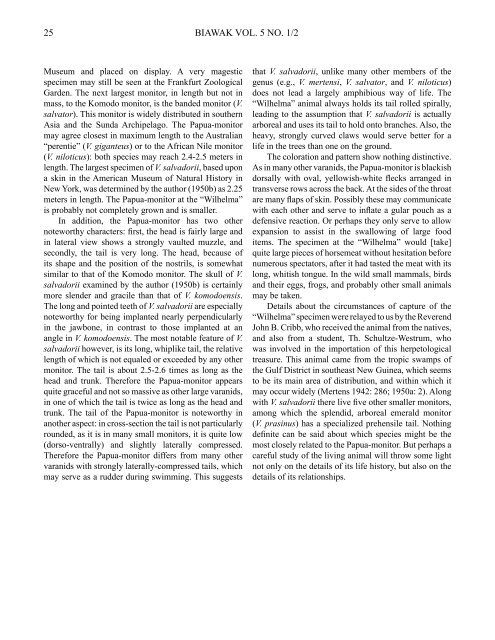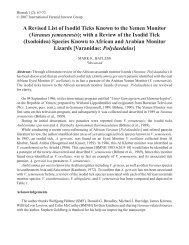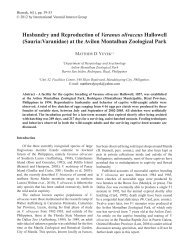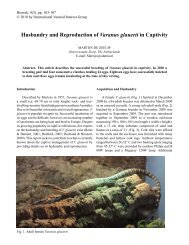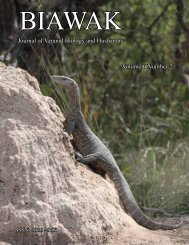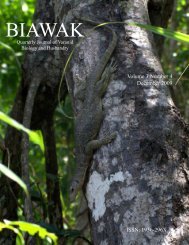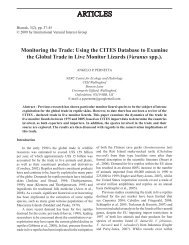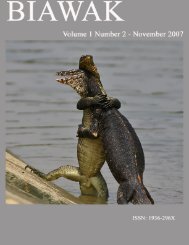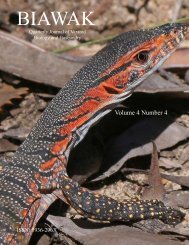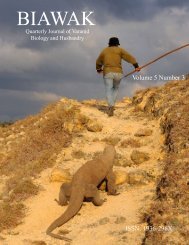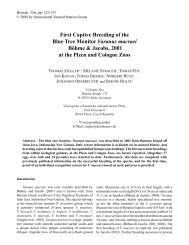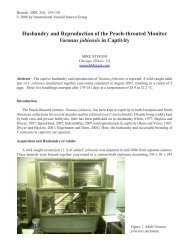BIAWAK - International Varanid Interest Group
BIAWAK - International Varanid Interest Group
BIAWAK - International Varanid Interest Group
Create successful ePaper yourself
Turn your PDF publications into a flip-book with our unique Google optimized e-Paper software.
25<strong>BIAWAK</strong> VOL. 5 NO. 1/2Museum and placed on display. A very magesticspecimen may still be seen at the Frankfurt ZoologicalGarden. The next largest monitor, in length but not inmass, to the Komodo monitor, is the banded monitor (V.salvator). This monitor is widely distributed in southernAsia and the Sunda Archipelago. The Papua-monitormay agree closest in maximum length to the Australian“perentie” (V. giganteus) or to the African Nile monitor(V. niloticus): both species may reach 2.4-2.5 meters inlength. The largest specimen of V. salvadorii, based upona skin in the American Museum of Natural History inNew York, was determined by the author (1950b) as 2.25meters in length. The Papua-monitor at the “Wilhelma”is probably not completely grown and is smaller.In addition, the Papua-monitor has two othernoteworthy characters: first, the head is fairly large andin lateral view shows a strongly vaulted muzzle, andsecondly, the tail is very long. The head, because ofits shape and the position of the nostrils, is somewhatsimilar to that of the Komodo monitor. The skull of V.salvadorii examined by the author (1950b) is certainlymore slender and gracile than that of V. komodoensis.The long and pointed teeth of V. salvadorii are especiallynoteworthy for being implanted nearly perpendicularlyin the jawbone, in contrast to those implanted at anangle in V. komodoensis. The most notable feature of V.salvadorii however, is its long, whiplike tail, the relativelength of which is not equaled or exceeded by any othermonitor. The tail is about 2.5-2.6 times as long as thehead and trunk. Therefore the Papua-monitor appearsquite graceful and not so massive as other large varanids,in one of which the tail is twice as long as the head andtrunk. The tail of the Papua-monitor is noteworthy inanother aspect: in cross-section the tail is not particularlyrounded, as it is in many small monitors, it is quite low(dorso-ventrally) and slightly laterally compressed.Therefore the Papua-monitor differs from many othervaranids with strongly laterally-compressed tails, whichmay serve as a rudder during swimming. This suggeststhat V. salvadorii, unlike many other members of thegenus (e.g., V. mertensi, V. salvator, and V. niloticus)does not lead a largely amphibious way of life. The“Wilhelma” animal always holds its tail rolled spirally,leading to the assumption that V. salvadorii is actuallyarboreal and uses its tail to hold onto branches. Also, theheavy, strongly curved claws would serve better for alife in the trees than one on the ground.The coloration and pattern show nothing distinctive.As in many other varanids, the Papua-monitor is blackishdorsally with oval, yellowish-white flecks arranged intransverse rows across the back. At the sides of the throatare many flaps of skin. Possibly these may communicatewith each other and serve to inflate a gular pouch as adefensive reaction. Or perhaps they only serve to allowexpansion to assist in the swallowing of large fooditems. The specimen at the “Wilhelma” would [take]quite large pieces of horsemeat without hesitation beforenumerous spectators, after it had tasted the meat with itslong, whitish tongue. In the wild small mammals, birdsand their eggs, frogs, and probably other small animalsmay be taken.Details about the circumstances of capture of the“Wilhelma” specimen were relayed to us by the ReverendJohn B. Cribb, who received the animal from the natives,and also from a student, Th. Schultze-Westrum, whowas involved in the importation of this herpetologicaltreasure. This animal came from the tropic swamps ofthe Gulf District in southeast New Guinea, which seemsto be its main area of distribution, and within which itmay occur widely (Mertens 1942: 286; 1950a: 2). Alongwith V. salvadorii there live five other smaller monitors,among which the splendid, arboreal emerald monitor(V. prasinus) has a specialized prehensile tail. Nothingdefinite can be said about which species might be themost closely related to the Papua-monitor. But perhaps acareful study of the living animal will throw some lightnot only on the details of its life history, but also on thedetails of its relationships.


